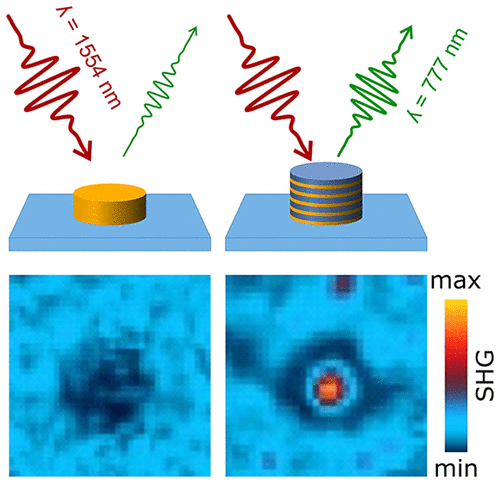当前位置:
X-MOL 学术
›
ACS Photonics
›
论文详情
Our official English website, www.x-mol.net, welcomes your feedback! (Note: you will need to create a separate account there.)
Enhanced Nonlinear Emission from Single Multilayered Metal–Dielectric Nanocavities Resonating in the Near-Infrared
ACS Photonics ( IF 7 ) Pub Date : 2021-01-14 , DOI: 10.1021/acsphotonics.0c01500 Nicolò Maccaferri 1 , Attilio Zilli 2 , Tommi Isoniemi 3, 4 , Lavinia Ghirardini 2 , Marzia Iarossi 4, 5 , Marco Finazzi 2 , Michele Celebrano 2 , Francesco De Angelis 4
ACS Photonics ( IF 7 ) Pub Date : 2021-01-14 , DOI: 10.1021/acsphotonics.0c01500 Nicolò Maccaferri 1 , Attilio Zilli 2 , Tommi Isoniemi 3, 4 , Lavinia Ghirardini 2 , Marzia Iarossi 4, 5 , Marco Finazzi 2 , Michele Celebrano 2 , Francesco De Angelis 4
Affiliation

|
Harmonic generation mechanisms are of great interest in nanoscience and nanotechnology, since they allow generating visible light by using near-infrared radiation, which is particularly suitable for its countless applications in bionanophotonics and optoelectronics. In this context, multilayer metal–dielectric nanocavities are widely used for light confinement and waveguiding at the nanoscale. They exhibit intense and localized resonances that can be conveniently tuned in the near-infrared and are therefore ideal for enhancing nonlinear effects in this spectral range. In this work, we experimentally investigate the nonlinear emission properties of multilayer metal–dielectric nanocavities. By engineering their absorption efficiency and exploiting their intrinsic interface-induced symmetry breaking, we achieve an almost 2 orders of magnitude higher second-harmonic generation efficiency compared to gold nanostructures featuring the same geometry and optical resonant behavior. In particular, while both the third-order nonlinear susceptibility and conversion efficiency are comparable with those of the Au nanoresonators, we estimate a second-order nonlinear susceptibility of the order of 1 pm/V, which is comparable with that of typical nonlinear crystals. We envision that our system, which combines the advantages of both plasmonic and dielectric materials, might enable the realization of composite and multifunctional nanosystems for the efficient manipulation of nonlinear optical processes at the nanoscale.
中文翻译:

单个多层金属介电纳米腔在近红外共振的增强非线性发射
谐波产生机理在纳米科学和纳米技术中引起了极大的兴趣,因为它们允许通过使用近红外辐射来产生可见光,这特别适合其在生物纳米光子学和光电子学中的无数应用。在这种情况下,多层金属介电纳米腔被广泛用于纳米级的光限制和波导。它们表现出强烈的局部共振,可以在近红外范围内方便地进行调谐,因此是增强该光谱范围内非线性效应的理想选择。在这项工作中,我们通过实验研究了多层金属-电介质纳米腔的非线性发射特性。通过设计其吸收效率并利用其固有的界面诱导的对称性破坏,与具有相同几何形状和光学共振行为的金纳米结构相比,我们的二次谐波产生效率提高了近2个数量级。特别是,尽管三阶非线性磁化率和转换效率都与金纳米谐振器相当,但我们估算的二阶非线性磁化率约为1 pm / V,与典型的非线性晶体相当。我们设想,我们的系统结合了等离激元和介电材料的优点,可能会实现复合纳米系统和多功能纳米系统的实现,以便在纳米级有效地处理非线性光学过程。虽然三阶非线性磁化率和转换效率与Au纳米谐振器相当,但我们估算的二阶非线性磁化率约为1 pm / V,与典型的非线性晶体相当。我们设想,我们的系统结合了等离激元和介电材料的优点,可能能够实现复合纳米系统和多功能纳米系统的实现,以便有效地处理纳米级的非线性光学过程。虽然三阶非线性磁化率和转换效率与Au纳米谐振器相当,但我们估算的二阶非线性磁化率约为1 pm / V,与典型的非线性晶体相当。我们设想,我们的系统结合了等离激元和介电材料的优点,可能会实现复合纳米系统和多功能纳米系统的实现,以便在纳米级有效地处理非线性光学过程。
更新日期:2021-02-17
中文翻译:

单个多层金属介电纳米腔在近红外共振的增强非线性发射
谐波产生机理在纳米科学和纳米技术中引起了极大的兴趣,因为它们允许通过使用近红外辐射来产生可见光,这特别适合其在生物纳米光子学和光电子学中的无数应用。在这种情况下,多层金属介电纳米腔被广泛用于纳米级的光限制和波导。它们表现出强烈的局部共振,可以在近红外范围内方便地进行调谐,因此是增强该光谱范围内非线性效应的理想选择。在这项工作中,我们通过实验研究了多层金属-电介质纳米腔的非线性发射特性。通过设计其吸收效率并利用其固有的界面诱导的对称性破坏,与具有相同几何形状和光学共振行为的金纳米结构相比,我们的二次谐波产生效率提高了近2个数量级。特别是,尽管三阶非线性磁化率和转换效率都与金纳米谐振器相当,但我们估算的二阶非线性磁化率约为1 pm / V,与典型的非线性晶体相当。我们设想,我们的系统结合了等离激元和介电材料的优点,可能会实现复合纳米系统和多功能纳米系统的实现,以便在纳米级有效地处理非线性光学过程。虽然三阶非线性磁化率和转换效率与Au纳米谐振器相当,但我们估算的二阶非线性磁化率约为1 pm / V,与典型的非线性晶体相当。我们设想,我们的系统结合了等离激元和介电材料的优点,可能能够实现复合纳米系统和多功能纳米系统的实现,以便有效地处理纳米级的非线性光学过程。虽然三阶非线性磁化率和转换效率与Au纳米谐振器相当,但我们估算的二阶非线性磁化率约为1 pm / V,与典型的非线性晶体相当。我们设想,我们的系统结合了等离激元和介电材料的优点,可能会实现复合纳米系统和多功能纳米系统的实现,以便在纳米级有效地处理非线性光学过程。


























 京公网安备 11010802027423号
京公网安备 11010802027423号